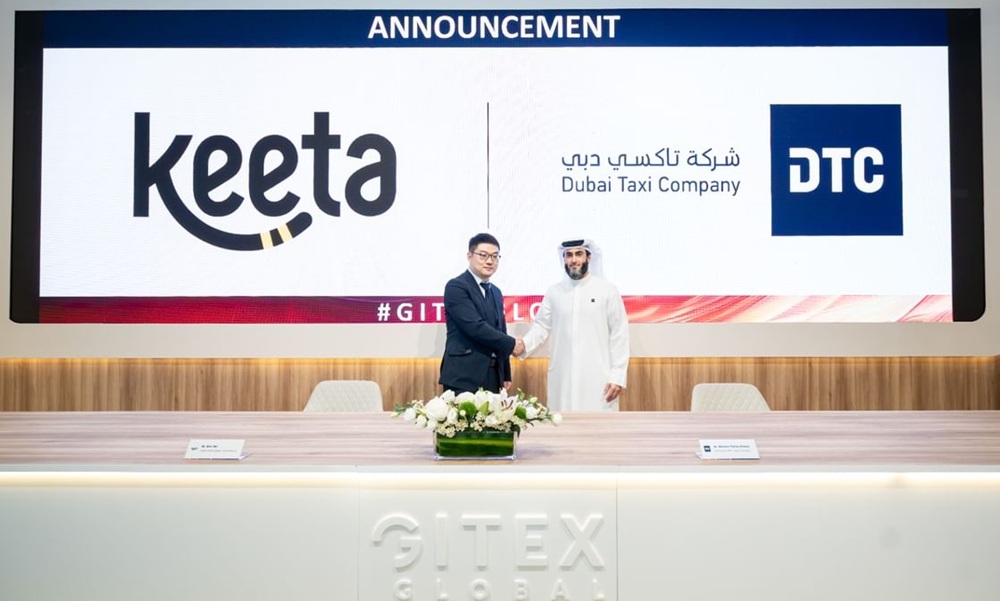At Gitex 2025, Dubai Taxi Company (DTC) has made waves not with passenger cars, but with delivery bikes. In a strategic collaboration with Keeta (the international arm of Chinese delivery giant Meituan), DTC is staking its claim in Dubai’s booming last-mile logistics sector.
Under the agreement, DTC will deploy an initial fleet of 150 delivery motorbikes, scaling up to 500 bikes by year-end. The projected revenue from this expansion is estimated to exceed AED 10 million in the first 12 months, said a reported by news agency WAM.
DTC’s delivery bike segment continues to experience strong growth, with revenues in Q2 2025 doubling and increasing by 102% year-on-year to AED18.2 million, reflecting the company’s ability to respond to shifting market needs and deliver high-quality logistics solutions.
In addition to scaling its motorbike fleet, the partnership will drive future collaboration on high-tech delivery solutions. Leveraging Keeta’s dedicated technology, both companies plan to explore the integration of drones and autonomous vehicles into Keeta’s logistics operations in partnership with DTC as part of Keeta’s logistics operations, managed in partnership with DTC.
Mansoor Rahma Alfalasi, CEO of Dubai Taxi Company, commented, “At DTC, we continue to strengthen our mobility and logistics solutions in line with Dubai’s vision for a connected and sustainable future. The UAE’s delivery and logistics market is expanding rapidly, driven by booming e-commerce and on-demand services.”
According to research by Statista online food delivery revenues alone projected to surpass AED5 billion in 2025 with an expected compound annual growth rate (CAGR) of more than 3% over the coming years set to take this figure to close to AED6 billion by 2030.
He added, “DTC is capitalising on this growth through its expanding fleet of over 2,000 delivery bikes and advanced operational capabilities. Partnering with Keeta further diversifies our services, maximises fleet potential, and positions DTC at the forefront of next-generation logistics, including drones and autonomous delivery technologies.”
Alex Wei, Logistics General Manager of Keeta Middle East, said, “We are proud to partner with Dubai Taxi Company to bring Keeta’s global delivery expertise and Meituan’s advanced logistics technologies to the UAE. This collaboration combines DTC’s strong local capabilities with our world-class innovation to build a smart, efficient, and sustainable delivery ecosystem. Together, we aim to strengthen last-mile delivery capabilities and play a meaningful role in the evolving mobility and logistics landscape.”
DTC’s move into delivery, powered by its Gitex announcement with Keeta, signals that mobility and logistics are becoming inseparable in the UAE. For fleet managers, rental houses, and transport operators, the lesson is clear: the future of fleet lies not just in moving people or goods, but in flexible, hybrid, intelligent mobility ecosystems.
What This Means for the UAE Fleet & Delivery Market
1. Taxis as Logistics Assets
As DTC transitions part of its fleet (or its operational mindset) toward delivery, we’re seeing a convergence of passenger mobility and freight movement. For rental houses and fleet operators, similar cross-utilization strategies may emerge — vehicles used for core tasks by day, delivery or logistics by night.
2. Rapid Scaling in E-commerce & Q-commerce
The UAE’s on-demand delivery market is growing at a blistering pace. DTC’s decision to scale its bike fleet underlines confidence in that growth. The partnership allows Keeta to combine global logistics technology with DTC’s local expertise and operational footprint. WAM
3. Tech-forward Logistics: Drones & Autonomy
Beyond bikes, the DTC–Keeta partnership envisions drones and autonomous vehicle integration in future delivery operations. WAM That’s a clear signal that future fleet strategies will need to account for mixed mobility — ground + aerial + autonomous — rather than only traditional trucks and vans.
4. Asset Utilisation & Revenue Diversification
DTC already reports an expanding 2,000-strong delivery bike fleet as part of its logistics operations. WAM By layering delivery services on top of existing mobility infrastructure, they unlock new revenue streams and improve asset utilization — lessons any fleet-driven business should watch.
Challenges & Considerations
-
Operational Complexity: Running a delivery service introduces new demands — routing, customer logistics, parcel handling, returns, etc. DTC will need systems and processes that differ from pure passenger transport.
-
Fleet Management: As fleets diversify across vehicle types (motorbikes, vans, drones), integrating fleet health, maintenance, and utilization across all assets will be key.
-
Regulation & Airspace: Drone and autonomous deployment may run into regulatory or safety constraints, especially in urban areas.
-
Margin Pressures: Last-mile delivery is notoriously margin-sensitive. Success will depend heavily on scale, turnaround, and cost control.
What Fleet & Rental Operators Should Watch
-
Partnership Models — Collaborations between mobility providers and delivery tech firms may become more common than pure OEM-based expansion.
-
Mixed-Fleet Strategies — Expect diversification: from bikes and vans to drones and autonomous platforms.
-
Data-Driven Operations — Real-time routing, demand forecasting, and intelligent load balancing will be competitive differentiators.
-
Cross-Utilisation — Idle vehicles or off-peak assets could be reassigned for delivery tasks, improving utilization and reducing cost-per-hour.



